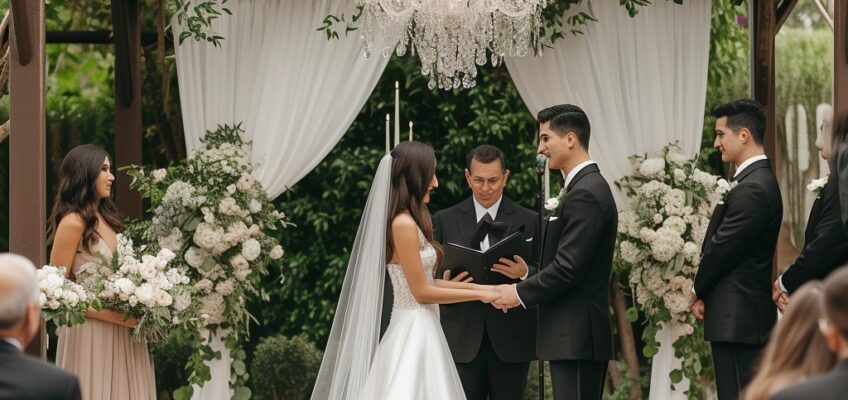Throughout history, the concept of the “wedding season” has evolved, reflecting the cultural, traditional, and personal preferences of couples. From the picturesque spring blossoms to the cozy winter wonderlands, each season offers its own unique charm and appeal. The most popular month for couples to say “I do” is undoubtedly June. This timeless month has long been revered as the quintessential wedding season, captivating the hearts of lovebirds worldwide.
Ideal weather conditions: June typically offers mild temperatures, low rainfall, and abundant sunshine, creating the perfect backdrop for outdoor ceremonies and celebrations.
Symbolic significance: June is historically associated with the Roman goddess Juno, the patron of marriage and childbirth, lending an air of divine blessing to nuptials.
School calendar alignment: With many schools wrapping up their academic year in June, it’s a convenient time for couples to tie the knot without disrupting work or academic schedules.
While June remains the undisputed champion of the wedding season, other months like August, September, and October have also gained popularity in recent years, as couples seek to avoid the peak summer heat or take advantage of the stunning fall foliage. The selection of the perfect wedding month is a multifaceted decision, influenced by a variety of factors..
- Seasonal Preferences:
- Couples may be drawn to the blooming flowers and lush greenery of spring, the sun-drenched warmth of summer, the vibrant hues of autumn, or the magical winter wonderland.
- Personal preferences, family traditions, and cultural backgrounds can all play a role in shaping the desired wedding season.
- Budget Considerations:
- Certain months may be more budget-friendly than others, with off-peak seasons often offering more affordable options for venues, catering, and other wedding services.
- Couples may also factor in the costs associated with seasonal floral arrangements, and other wedding-related expenses.
- Symbolic and Emotional Significance:
- Some couples may be drawn to the symbolic meaning of a particular month, such as the anniversary of their first date or a meaningful personal connection.
- Emotional factors, such as the desire to create a lasting memory or honor family traditions, can also shape the decision.
Historical and Cultural Significance of Popular Wedding Months
The preference for specific wedding months is deeply rooted in the tapestry of history, culture and has influenced the popularity of certain months over time. Each season offers its own unique set of advantages and challenges when it comes to planning a wedding. The pros and cons of tying the knot during different times of the year.
June: The Quintessential Wedding Month
June’s association with the Roman goddess Juno has contributed to its enduring appeal as the premier wedding month. In many cultures, June has been linked to the onset of summer, a time of abundance, fertility, and new beginnings, making it an auspicious choice for nuptials. The spring to summer months pros and cons are:
- Pros: Mild weather, blooming flowers, and lush greenery provide a picturesque backdrop. Availability of venues and vendors may be higher.
- Cons: Unpredictable weather, potential for rain, and increased competition for venues and vendors during the peak season.
Summer (June-August):
- Pros: Abundant sunshine, warm temperatures, and the opportunity for outdoor celebrations. Availability of seasonal produce and floral options.
- Cons: Potential for extreme heat, higher prices during peak season, and increased travel costs for guests.
- August and September: The Harvest Months:
- In agrarian societies, August and September were often seen as prosperous times, with the harvest season providing a sense of abundance and stability. Couples may have chosen these months to symbolize the fruitfulness and security that a new marriage could bring.
Fall (September-November):
- Pros: Stunning fall foliage, comfortable temperatures, and a sense of cozy, intimate ambiance. Availability of venues and vendors may be higher.
- Cons: Unpredictable weather, potential for rain or wind, and increased competition for venues and vendors
- December and the Winter Solstice:
- In many ancient traditions, the winter solstice was celebrated as a time of renewal and rebirth, with the return of longer days signifying hope and new beginnings. Some cultures have embraced the cozy, intimate atmosphere of winter weddings, finding beauty in the snowy landscapes and the warm glow of candlelight.
Winter (December-February):
- Pros: Enchanting winter wonderland settings, availability of venues and vendors, and potential for cost savings.
- Cons: Inclement weather, decreased availability of outdoor venues, and the potential for higher travel costs for guests
- Cultural and Regional Variations:
- In some Asian countries, the Lunar New Year period is a popular time for weddings, while in the Middle East, the month of Ramadan may be avoided.
Interestingly, some couples are bucking the traditional trends and opting for “off-season” weddings in the colder months, finding charm in the cozy, intimate ambiance of winter celebrations.


Leave a Reply